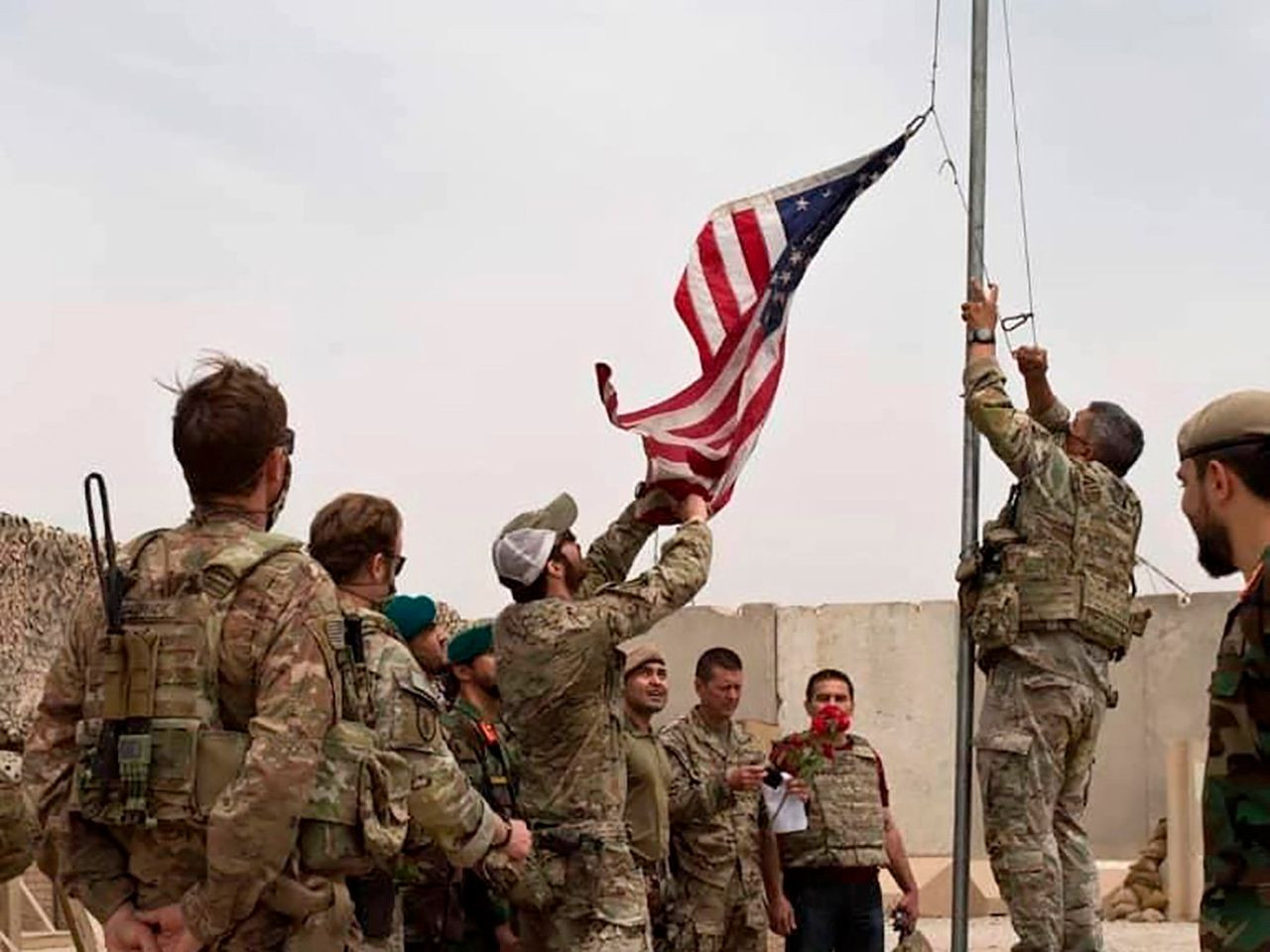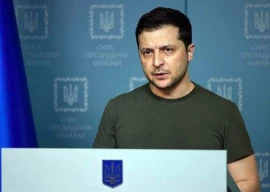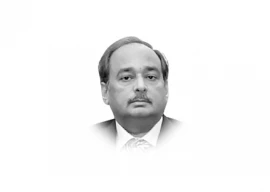
September 2001:
On September 11, 2001, between 7 and 9 am, al Qaeda operatives hijack four commercial airlines and strike the United States. Two planes crash into New York's World Trade Centre, one into the Pentagon in Washington, DC, and the fourth plane crashes into a field in Shanksville, Pennsylvania. At least three thousand people die.
![The second tower of the World Trade Center bursts into flames after being hit by a hijacked airplane, September 11, 2001. [Photo: Reuters]](https://i.tribune.com.pk/media/images/21631348673-1/21631348673-1.jpeg)
The second tower of the World Trade Center bursts into flames after being hit by a hijacked airplane, September 11, 2001. [Photo: Reuters]
![The towers of the World Trade Center pour smoke shortly after being struck by hijacked commercial aircraft, September 11, 2001. [Photo: Reuters]](https://i.tribune.com.pk/media/images/11631348673-0/11631348673-0.jpeg)
The towers of the World Trade Center pour smoke shortly after being struck by hijacked commercial aircraft, September 11, 2001. [Photo: Reuters]
![A medical rescue helicopter hovered above the Pentagon as firefighters battled flames after Flight 77 crashed into the US military headquarters on September 11, 2001 [Photo: Reuters]](https://i.tribune.com.pk/media/images/pentagon1631348802-0/pentagon1631348802-0.png)
A medical rescue helicopter hovered above the Pentagon as firefighters battled flames after Flight 77 crashed into the US military headquarters on September 11, 2001 [Photo: Reuters]
![Investigative personnel search the crash site of United Airlines Flight 93 looking for debris and evidence on 12 September 2001 in Shanksville, Pennsylvania. The hijacked plane crashed, killing all people on board. [Photo: AFP]](https://i.tribune.com.pk/media/images/afp1631349025-0/afp1631349025-0.jpg)
Investigative personnel search the crash site of United Airlines Flight 93 looking for debris and evidence on 12 September 2001 in Shanksville, Pennsylvania. The hijacked plane crashed, killing all people on board. [Photo: AFP]
Members of al Qaeda later claimed that the intended target of the attacks was the United States Capitol building in Washington, DC.
October - December 2001:
Following the deadly September 11 terrorist attacks, the United States launched a war on terror in Afghanistan - which was under the control of the Taliban, an extremist insurgent group.
Even though none of the hijackers was Afghan, US President George W Bush's administration categorised Taliban leaders as terrorists because they had given al Qaeda protection and refused to hand over its ringleader - Osama Bin Laden.
Bush authorised the use of force against those responsible for the attack and signed a joint resolution into law. This resolution later became a legal rationale for the Bush administration taking sweeping measures to combat terrorism, from breaching the privacy of US citizens and eavesdropping on them without a court order to invading Afghanistan.
![US Marines begin to form up their convoy at a staging area near Kandahar, as they await orders to begin their trek to Kandahar to take control of the airfield, December 13, 2001. [Photo: Reuters]](https://i.tribune.com.pk/media/images/2001-(2)1631348672-2/2001-(2)1631348672-2.jpeg)
US Marines begin to form up their convoy at a staging area near Kandahar, as they await orders to begin their trek to Kandahar to take control of the airfield, December 13, 2001. [Photo: Reuters]
![An Afghan girl peers out from behind a wall at passing US Marines driving inside light armored vehicles down Route 4 outside the Kandahar airport, December 27, 2001. [Photo: Reuters]](https://i.tribune.com.pk/media/images/20011631348672-3/20011631348672-3.jpeg)
An Afghan girl peers out from behind a wall at passing US Marines driving inside light armoured vehicles down Route 4 outside the Kandahar airport, December 27, 2001. [Photo: Reuters]
Following this, the US officially launched Operation Enduring Freedom and garnered support against the Taliban forces from the British, Canada, Australia, Germany and France. In Afghanistan, the Northern Alliance and ethnic Pashtun anti-Taliban forces also joined hands with the US.
Consequently, the Afghan invasion began with airstrikes on the insurgent group. Subsequently, the Taliban stronghold crumbled after the coalition and its loss at Mazar-e-Sharif on November 9, 2001.
However, in December, despite US intelligence at work and US forces successful against al Qaeda militants, Osama Bin Laden escaped.
March 2002:
With Osama Bin Laden on the run and al Qaeda militants under hiding, the US launched Operation Anaconda against an estimated 800 al Qaeda and Taliban fighters in the Shah-i-Kot Valley in Afghanistan's Paktia province.
![US Army 10th Mountain Division soldier Jorge Avino from Miami, Florida carves the body count that their mortar team has chalked up on a rock, near the villages of Sherkhankheyl, Marzak and Bobelkiel, in Afghanistan, March 9, 2002. [Photo: Reuters]](https://i.tribune.com.pk/media/images/20021631348673-5/20021631348673-5.jpeg)
US Army 10th Mountain Division soldier Jorge Avino from Miami, Florida carves the body count that their mortar team has chalked up on a rock, near the villages of Sherkhankheyl, Marzak and Bobelkiel, in Afghanistan, March 9, 2002. [Photo: Reuters]
Around two thousand US and one thousand Afghan troops fought the militants. However, it was in March that US intelligence and Pentagon planners began shifting resources away from Afghanistan in the direction of Saddam Hussein's Iraq, citing it as a major US threat in the war on terror.
![US soldiers in Iraq, 2002. [Photo: US Department of Defense]](https://i.tribune.com.pk/media/images/20021631351780-0/20021631351780-0.jpg)
US soldiers in Iraq, 2002. [Photo: US Department of Defense]
May - August 2003:
By May of 2003, the US had achieved its goals. The leaders of al Qaeda and the Taliban were either dead, captured or in hiding. Defense Secretary Donald Rumsfield had also announced that major combat operations had ended in Afghanistan and President Bush had declared 'mission accomplished; in Iraq the same day.
![Defense Secretary Donald Rumsfeld, right, addresses the media with UK Defense Secretary Geoff Hoon at London's Heathrow, airport May 2, 2003. [Photo: Reuters]](https://i.tribune.com.pk/media/images/20031631348673-6/20031631348673-6.jpeg)
Defense Secretary Donald Rumsfeld, right, addresses the media with UK Defense Secretary Geoff Hoon at London's Heathrow, airport May 2, 2003. [Photo: Reuters]
However, instead of withdrawing forces, the US government started to blur its strategic objective. In August, the North Atlantic Treaty Organisation (NATO) assumed control of international security forces in Afghanistan.
January - October 2004:
Hamid Karzai wins the election and becomes the first democratically elected head of Afghanistan. But in October, Osama Bin Laden resurfaces.
Three weeks after the country's presidential election, Laden takes responsibility for the September 11, 2001, terrorist attacks and taunts the Bush administration in a prerecorded video.
"We want to restore freedom to our nation, just as you lay waste to our nation," he says in the video.
![A frame grab (L) taken 29 October 2004 from a videotape aired by Al-Jazeera news channel shows al Qaeda leader Osama bin Laden. [Photo: AFP]](https://i.tribune.com.pk/media/images/20041631348673-7/20041631348673-7.jpg)
A frame grab (L) taken 29 October 2004 from a videotape aired by Al-Jazeera news channel shows al Qaeda leader Osama bin Laden. [Photo: AFP]
2005:
Despite the insurgency, Afghans vote in the country's first free legislative elections in more than 25 years in September 2005.
As Afghanistan's nation-building campaign continues, the US begins to train the Afghan National Police force. Hamid Karzai and George Bush issue a joint declaration that makes the two countries strategic partners. This declaration gives US forces access to Afghan military facilities and forms an alliance to strengthen US-Afghan ties.
![Afghan women show their inked fingers after they voted during parliamentary elections at a mosque used as a polling station in the Afghan capital Kabul, September 18, 2005. [Photo: Reuters]](https://i.tribune.com.pk/media/images/20051631348673-8/20051631348673-8.jpeg)
Afghan women show their inked fingers after they voted during parliamentary elections at a mosque used as a polling station in the Afghan capital Kabul, September 18, 2005. [Photo: Reuters]
2006:
Despite coalition with the US, violence increase across Afghanistan. There is a four-fold increase in the number of suicide attacks and twofold in the number of detonated bombings.
Afghanis start to riot against American-led military forces.
![Kabul rioters threw rocks at a military vehicle belonging to the American-led military forces in Afghanistan. [Photo: AFP]](https://i.tribune.com.pk/media/images/20061631354480-0/20061631354480-0.jpg)
Kabul rioters threw rocks at a military vehicle belonging to the American-led military forces in Afghanistan. [Photo: AFP]
2007:
Taliban Military Commander Mullah Dadullah is killed in a joint operation by the Afghan, US and NATO forces in southern Afghanistan.
According to media reports, Dadullah was a leader of guerrilla forces in the war in Helmand province. He was the Taliban's most feared commander and was responsible for the increase in targeted killings and suicide bombings in 2006.
In an interview with the BBC, he once said that scores of suicide bombers awaited his command to launch an offensive against foreign troops.
His death resulted in increased US military forces in Afghanistan.
![A French sniper looks through his rifle's scope while keeping watch over Qarabagh district, north of Kabul, November 20, 2007. [Photo: Reuters]](https://i.tribune.com.pk/media/images/20071631348672-10/20071631348672-10.jpeg)
A French sniper looks through his rifle's scope while keeping watch over Qarabagh district, north of Kabul, November 20, 2007. [Photo: Reuters]
2008:
The media is replete with stories of collateral killings in Afghanistan at this point in time. What started as a war on terror has turned into a gunship killing thousands of innocent Afghan civilians.
![Sgt. William Olas Bee, a US Marine from the 24th Marine Expeditionary Unit, has a close call after Taliban fighters opened fire near Garmsir in Helmand Province of Afghanistan, May 18, 2008. [Photo: Reuters]](https://i.tribune.com.pk/media/images/20081631348673-12/20081631348673-12.jpeg)
Sgt. William Olas Bee, a US Marine from the 24th Marine Expeditionary Unit, has a close call after Taliban fighters opened fire near Garmsir in Helmand Province of Afghanistan, May 18, 2008. [Photo: Reuters]
![US Army soldiers and an Afghan policeman look at the bodies of Taliban fighters after a 40-minute gun battle near the village of Shajoy in Zabol province March 22, 2008. [Photo: Reuters]](https://i.tribune.com.pk/media/images/2008-(2)1631348673-11/2008-(2)1631348673-11.jpeg)
US Army soldiers and an Afghan policeman look at the bodies of Taliban fighters after a 40-minute gun battle near the village of Shajoy in Zabol province March 22, 2008. [Photo: Reuters]
2009:
Newly elected US President Barack Obama recommits to Afghanistan and announces his plan to send seventeen thousand more troops to the war zone on top of the sixty-eight thousand in place.
President Obama also announces a new strategy for the old war, linking success in Afghanistan to a stable Pakistan. He announces a major escalation - to 'disrupt, dismantle and defeat' al Qaeda in its alleged safe haven in Pakistan. And to prevent their return to Afghanistan and Pakistan.
In October, President Obama commits an additional thirty thousand forces to the fight.
President Karzai welcomes the new strategy.
![A Canadian army medic examines one of eight children brought to a forward operating base after they fell gravely ill from eating explosive powder at a home in the Panjwai district of Kandahar province, September 12, 2009. [Photo: Reuters]](https://i.tribune.com.pk/media/images/2009-(2)1631348673-13/2009-(2)1631348673-13.jpeg)
A Canadian army medic examines one of eight children brought to a forward operating base after they fell gravely ill from eating explosive powder at a home in the Panjwai district of Kandahar province, September 12, 2009. [Photo: Reuters]
![Afghan children look at Canadian soldiers of the NATO-led coalition while they patrol in their compound in the Taliban stronghold of Zhari district in Kandahar province, southern Afghanistan, March 19, 2009. [Photo: Reuters]](https://i.tribune.com.pk/media/images/2009-(3)1631348673-14/2009-(3)1631348673-14.jpeg)
Afghan children look at Canadian soldiers of the NATO-led coalition while they patrol in their compound in the Taliban stronghold of Zhari district in Kandahar province, southern Afghanistan, March 19, 2009. [Photo: Reuters]
2010:
NATO member countries sign a declaration agreeing to hand over full responsibility for security in Afghanistan to Afghan forces by the end of 2014. However, the transition process would begin in July 2011.
![An Afghan man is detained by US Marines from the First Battalion, Eighth Marines Bravo Company at their base in Talibjan after a battle against Taliban insurgents in Musa Qala district in southern Afghanistan's Helmand province November 7, 2010. [Photo: Reuters]](https://i.tribune.com.pk/media/images/20101631348673-17/20101631348673-17.jpeg)
An Afghan man is detained by US Marines from the First Battalion, Eighth Marines Bravo Company at their base in Talibjan after a battle against Taliban insurgents in Musa Qala district in southern Afghanistan's Helmand province November 7, 2010. [Photo: Reuters]
2011:
Osama Bin Laden is killed.
The al Qaeda ringleader is killed by the US special forces in Abbottabad, Pakistan. He was buried at sea.
Simultaneously, anti-Pakistan rhetoric grows in Afghanistan where officials begin to blame alleged terrorist camps in Pakistan for violence in Afghanistan.
The US war in Afghanistan marks its tenth anniversary and President Obama plans to withdraw troops from Afghanistan after pressure from democrats and US citizens.
1631348674-18/2011-(2)1631348674-18.jpg)
File Photo
![The grounds of the compound are seen after US Navy SEAL commandos killed al Qaeda leader Osama bin Laden in Abbottabad May 2, 2011. [Photo: Reuters]](https://i.tribune.com.pk/media/images/2011-(3)1631348674-19/2011-(3)1631348674-19.jpg)
The grounds of the compound are seen after US Navy SEAL commandos killed al Qaeda leader Osama bin Laden in Abbottabad May 2, 2011. [Photo: Reuters]
The US hopes for a deal with the Taliban to help wind down the conflict.
2012:
As US troops start exiting the war-ravaged Afghanistan and Afghan officials seek a political settlement to ensure a stable Afghanistan, tensions flare as the Taliban suspend primary talks and accuse the US of reneging on promises to take meaningful steps towards a prisoner swap.
![Paratroopers from Chosen Company of the 3rd Battalion (Airborne), 509th Infantry board a waiting CH-47 Chinook helicopter as they begin a helicopter assault mission at Combat Outpost Herrera in Afghanistan's Paktiya Province, July 15, 2012. [Photo: Reuters]](https://i.tribune.com.pk/media/images/20121631348673-22/20121631348673-22.jpeg)
Paratroopers from Chosen Company of the 3rd Battalion (Airborne), 509th Infantry board a waiting CH-47 Chinook helicopter as they begin a helicopter assault mission at Combat Outpost Herrera in Afghanistan's Paktiya Province, July 15, 2012. [Photo: Reuters]
2013:
Afghan security takeover is complete as Afghan forces take the lead and NATO hands over control of the remaining ninety-five districts.
![A soldier from 1st Platoon, Alpha Company, 1st Battalion, 36th Infantry leaves a room while checking the inventory of weapons at Strong Point DeMaiwand, Maywand District, Kandahar Province, Afghanistan, January 20, 2013. [Photo: Reuters]](https://i.tribune.com.pk/media/images/20131631348673-23/20131631348673-23.jpeg)
A soldier from 1st Platoon, Alpha Company, 1st Battalion, 36th Infantry leaves a room while checking the inventory of weapons at Strong Point DeMaiwand, Maywand District, Kandahar Province, Afghanistan, January 20, 2013. [Photo: Reuters]
2014:
President Obama announces troop withdrawal in May.
In September, the newly elected President Ashraf Ghani signs a power-sharing agreement with his opponent Abdullah Abdullah to ward off civil unrest in the country.
![Smoke and flames rise from fuel trucks after an overnight attack by the Taliban on the outskirts of Kabul, July 5, 2014. [Photo: Reuters]](https://i.tribune.com.pk/media/images/20141631348673-24/20141631348673-24.jpeg)
Smoke and flames rise from fuel trucks after an overnight attack by the Taliban on the outskirts of Kabul, July 5, 2014. [Photo: Reuters]
![A US soldier from the 3rd Cavalry Regiment pays his respects during a memorial for Specialist Wyatt Martin and Sergeant First Class Ramon Morris at Bagram Air Field in the Parwan province of Afghanistan, December 23, 2014. Specialist Martin and Sergeant First Class Ramon were killed on December 12th by an improvised explosive device while on patrol near Bagram Air Field. [Photo: Reuters]](https://i.tribune.com.pk/media/images/20151631348673-25/20151631348673-25.jpeg)
A US soldier from the 3rd Cavalry Regiment pays his respects during a memorial for Specialist Wyatt Martin and Sergeant First Class Ramon Morris at Bagram Air Field in the Parwan province of Afghanistan, December 23, 2014. Specialist Martin and Sergeant First Class Ramon were killed on December 12th by an improvised explosive device while on patrol near Bagram Air Field. [Photo: Reuters]
2016:
Saying the security situation in Afghanistan 'remains precarious', President Obama announces that instead of dropping the US troop level to 5,500, he will keep it at about 8,400 through the end of his term in January 2017.
Further, the US government proposes the US $860 million in aid for Pakistan during the 2016-17 fiscal year, including $265 million for military hardware in addition to counterinsurgency funds.
![US President Barack Obama, surrounded by US Secretary of Defense Ash Carter (L) and the Chairman of the Joint Chiefs of Staff USMC General Joseph Dunford, Jr, (R) delivers a statement from the Roosevelt Room on Afghanistan at the White House in Washington US July 6, 2016. [Photo: Reuters]](https://i.tribune.com.pk/media/images/20161631348675-26/20161631348675-26.jpg)
US President Barack Obama, surrounded by US Secretary of Defense Ash Carter (L) and the Chairman of the Joint Chiefs of Staff USMC General Joseph Dunford, Jr, (R) delivers a statement from the Roosevelt Room on Afghanistan at the White House in Washington US July 6, 2016. [Photo: Reuters]
2017:
As the US elects its new President - Donald Trump - the US attacks the Islamic State militants at a cave near eastern Nangarhar province with its most powerful non-nuclear bomb.
The bombing results in the US military describing the war with the Taliban as a stalemate, while suicide bombings in Kabul reach new levels.
As a result, President Trump prolongs the Afghan war.
![This photograph taken on October 8, 2017 shows Afghan Wakhi nomad family posing for a picture in the Wakhan Corridor in Afghanistan. The region is so remote that its residents, known as the Wakhi - a tribe of roughly 12,000 nomadic people who populate the area - are untouched by decades of conflict devastating their country. [Photo: AFP]](https://i.tribune.com.pk/media/images/new1631358283-0/new1631358283-0.png)
This photograph taken on October 8, 2017 shows Afghan Wakhi nomad family posing for a picture in the Wakhan Corridor in Afghanistan. The region is so remote that its residents, known as the Wakhi - a tribe of roughly 12,000 nomadic people who populate the area - are untouched by decades of conflict devastating their country. [Photo: AFP]
2018:
The Taliban carry out a series of major attacks following Trump's plans of prolonging the war. While the US launches airstrikes against opium labs to decimate the Taliban finances.
In addition, the Trump administration also cuts off security assistance worth billions of dollars to Pakistan for allegedly harbouring militants.
![Afghan security personnel and civilians gather next to a damaged car at the site of a car bomb attack in Kabul on March 17, 2018. [Photo: AFP]](https://i.tribune.com.pk/media/images/20181631359081-0/20181631359081-0.jpg)
Afghan security personnel and civilians gather next to a damaged car at the site of a car bomb attack in Kabul on March 17, 2018. [Photo: AFP]
2019:
In February, negotiations between the US and the Taliban in Doha enter their highest level and peace talks between US special envoy Zalmay Khalilzad and top Taliban official Mullah Abdul Ghani Baradar centre on the US withdrawing its troops from the war-ravaged country in exchange for the Taliban blocking international terrorist groups from operating on Afghan soil.
However, President Trump abruptly cancels the peace talks after a US soldier is killed in a Taliban attack in September.
![A seventh round of talks between the warring sides begins in Qatar’s capital of Doha. [Photo: Reuters]](https://i.tribune.com.pk/media/images/20191631348673-29/20191631348673-29.jpg)
A seventh round of talks between the warring sides begins in Qatar’s capital of Doha. [Photo: Reuters]
2020:
The Taliban and US sign a peace treaty that paves way for a drawdown of US troops in Afghanistan and guarantees that the Taliban will not use Afghanistan for terrorist activities.
Intra-Afghan negotiations also begin.
However, the US-Taliban deal does not call for an immediate cease-fire, resulting in continued airstrikes and dozens of attacks.
![Mullah Abdul Ghani Baradar, the leader of the Taliban delegation, and Zalmay Khalilzad, US envoy for peace in Afghanistan, shake hands after signing an agreement at a ceremony between members of Afghanistan's Taliban and the US in Doha, Qatar February 29, 2020. [Photo: Reuters]](https://i.tribune.com.pk/media/images/20201631359913-0/20201631359913-0.jpeg)
Mullah Abdul Ghani Baradar, the leader of the Taliban delegation, and Zalmay Khalilzad, US envoy for peace in Afghanistan, shake hands after signing an agreement at a ceremony between members of Afghanistan's Taliban and the US in Doha, Qatar February 29, 2020. [Photo: Reuters]
2021:
In April, President Joe Biden decides to complete US withdrawal by 9/11. However, in a stunning defeat to the US, the Taliban take over Kabul in August.
While President Ghani flees the country, Biden defends troop withdrawal.
In these fast-moving developments, the Taliban on Tuesday announced an all-male interim government for Afghanistan stacked with veterans of their hard-line rule from the 1990s and the 20-year battle against the US-led coalition, a move that seems unlikely to win the international support the new leaders desperately need to avoid an economic meltdown.
![Taliban fighters pose in Afghanistan’s presidential palace. [File Photo]](https://i.tribune.com.pk/media/images/latest1631360743-0/latest1631360743-0.jpg)
Taliban fighters pose in Afghanistan’s presidential palace. [File Photo]
![Afghan people climb atop a plane as they wait at the Kabul airport. [Photo: AFP]](https://i.tribune.com.pk/media/images/image1631360911-0/image1631360911-0.png)
Afghan people climb atop a plane as they wait at the Kabul airport. [Photo: AFP]








1737406890-0/Elon-Musk-(4)1737406890-0-270x192.webp)














COMMENTS
Comments are moderated and generally will be posted if they are on-topic and not abusive.
For more information, please see our Comments FAQ